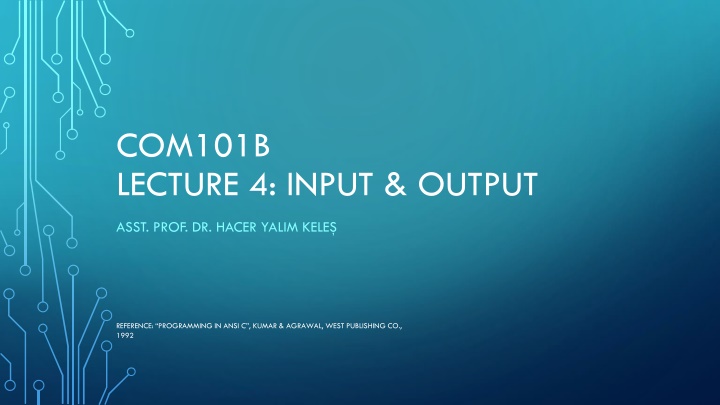
Input and Output Operations in ANSI C Programming
Learn about input and output operations in ANSI C programming including the printf and scanf functions, format specifiers, and how to utilize the standard I/O library to enhance your C programs. Get insights from Asst. Prof. Dr. Hacer Yalim Kele's lecture materials and references to Programming in ANSI C by Kumar & Agrawal.
Download Presentation

Please find below an Image/Link to download the presentation.
The content on the website is provided AS IS for your information and personal use only. It may not be sold, licensed, or shared on other websites without obtaining consent from the author. If you encounter any issues during the download, it is possible that the publisher has removed the file from their server.
You are allowed to download the files provided on this website for personal or commercial use, subject to the condition that they are used lawfully. All files are the property of their respective owners.
The content on the website is provided AS IS for your information and personal use only. It may not be sold, licensed, or shared on other websites without obtaining consent from the author.
E N D
Presentation Transcript
COM101B LECTURE 4: INPUT & OUTPUT ASST. PROF. DR. HACER YALIM KELE REFERENCE: PROGRAMMING IN ANSI C , KUMAR & AGRAWAL, WEST PUBLISHING CO., 1992
C does not provide language constructs for input/output operations. However, ANSI C has defined a rich standard I/O library: a set of functions designed to provide a standard I/O system for C programs. We will study some subset of this library: printf: used for output operations scanf: used for input operations A program that uses I/O functions needs to include <stdio.h>: #include <stdio.h> REFERENCE: PROGRAMMING IN ANSI C , KUMAR & AGRAWAL, WEST PUBLISHING CO., 1992
Example: printf( %c , C ); results in: > C Here > represent the output prompt. REFERENCE: PROGRAMMING IN ANSI C , KUMAR & AGRAWAL, WEST PUBLISHING CO., 1992
PRINTF FUNCTION The printf statement: int i = 1; printf( %d\n , 2*i); results in: > 2 The printf statement: float r = 100.0; printf( \n%f\t%e , r, 100.0); results in: >100.000000 1.000000e+002 REFERENCE: PROGRAMMING IN ANSI C , KUMAR & AGRAWAL, WEST PUBLISHING CO., 1992
PRINTF FUNCTION The printf statement: float c = -11.428572; printf( %f Cent = %f %s\n , c, 1.8*c+32, Fahr ); >-11.428572 Cent = 11.428571 Fahr REFERENCE: PROGRAMMING IN ANSI C , KUMAR & AGRAWAL, WEST PUBLISHING CO., 1992
PRINTF FUNCTION The blank characters in the control string are significant: printf( 1 2 3 4 end\n ); >1 2 3 4 end REFERENCE: PROGRAMMING IN ANSI C , KUMAR & AGRAWAL, WEST PUBLISHING CO., 1992
FORMAT SPECIFIERS REFERENCE: PROGRAMMING IN ANSI C , KUMAR & AGRAWAL, WEST PUBLISHING CO., 1992
SCANF FUNCTION It is the input analog of the printf function scanf(control string, arg1, arg2,...); The control string contains conversion specifications. The scanf function reads one data item from the input corresponding to each argument other than the control string skipping the whitespaces including newlines to find the next data item, and returns the total number of arguments that are successfully read. It returns EOF (End Of File) when the end of the input is reached. REFERENCE: PROGRAMMING IN ANSI C , KUMAR & AGRAWAL, WEST PUBLISHING CO., 1992
CONVERSION CONTROL CHARS REFERENCE: PROGRAMMING IN ANSI C , KUMAR & AGRAWAL, WEST PUBLISHING CO., 1992
SCANF FUNCTION Example: int i; float f1, f2; char c1, c2; Input: 10 1.0e1 10.0pc Statement: scanf( %d %f %e %c %c ,&i,&f1,&f2,&c1,&c2); results in: i = 10; f1=10.000000; f2=10.000000; c1= p ; c2= c REFERENCE: PROGRAMMING IN ANSI C , KUMAR & AGRAWAL, WEST PUBLISHING CO., 1992




















